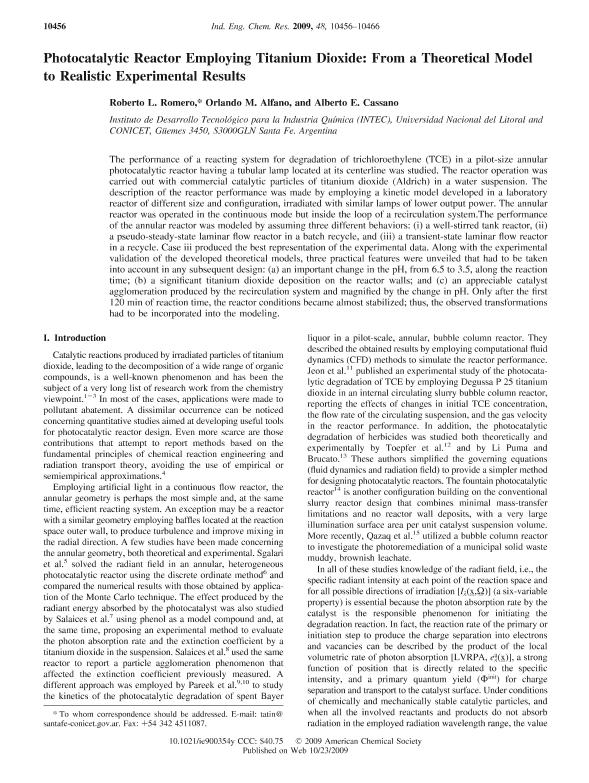Mostrar el registro sencillo del ítem
dc.contributor.author
Romero, Roberto Leopoldo

dc.contributor.author
Alfano, Orlando Mario

dc.contributor.author
Cassano, Alberto Enrique

dc.date.available
2017-08-01T14:38:07Z
dc.date.issued
2009-12
dc.identifier.citation
Romero, Roberto Leopoldo; Alfano, Orlando Mario; Cassano, Alberto Enrique; Photocatalytic reactor employing titanium dioxide: from a theoretical model to realistic experimental results; American Chemical Society; Industrial & Engineering Chemical Research; 48; 23; 12-2009; 10456-10466
dc.identifier.issn
0888-5885
dc.identifier.uri
http://hdl.handle.net/11336/21697
dc.description.abstract
The performance of a reacting system for degradation of trichloroethylene (TCE) in a pilot-size annular photocatalytic reactor having a tubular lamp located at its centerline was studied. The reactor operation was carried out with commercial catalytic particles of titanium dioxide (Aldrich) in a water suspension. The description of the reactor performance was made by employing a kinetic model developed in a laboratory reactor of different size and configuration, irradiated with similar lamps of lower output power. The annular reactor was operated in the continuous mode but inside the loop of a recirculation system. The performance of the annular reactor was modeled by assuming three different behaviors: (i) a well-stirred tank reactor, (ii) a pseudo-steady-state laminar flow reactor in a batch recycle, and (iii) a transient-state laminar flow reactor in a recycle. Case iii produced the best representation of the experimental data. Along with the experimental validation of the developed theoretical models, three practical features were unveiled that had to be taken into account in any subsequent design: (a) an important change in the pH, from 6.5 to 3.5, along the reaction time; (b) a significant titanium dioxide deposition on the reactor walls; and (c) an appreciable catalyst agglomeration produced by the recirculation system and magnified by the change in pH. Only after the first 120 min of reaction time, the reactor conditions became almost stabilized; thus, the observed transformations had to be incorporated into the modeling.
dc.format
application/pdf
dc.language.iso
eng
dc.publisher
American Chemical Society

dc.rights
info:eu-repo/semantics/openAccess
dc.rights.uri
https://creativecommons.org/licenses/by-nc-sa/2.5/ar/
dc.subject
Trichloroethylene
dc.subject
Photocatalytic Reactor
dc.subject
Titanium Dioxide
dc.subject
Annular Reactor
dc.subject.classification
Ingeniería de Procesos Químicos

dc.subject.classification
Ingeniería Química

dc.subject.classification
INGENIERÍAS Y TECNOLOGÍAS

dc.title
Photocatalytic reactor employing titanium dioxide: from a theoretical model to realistic experimental results
dc.type
info:eu-repo/semantics/article
dc.type
info:ar-repo/semantics/artículo
dc.type
info:eu-repo/semantics/publishedVersion
dc.date.updated
2017-07-28T15:15:16Z
dc.journal.volume
48
dc.journal.number
23
dc.journal.pagination
10456-10466
dc.journal.pais
Estados Unidos

dc.description.fil
Fil: Romero, Roberto Leopoldo. Consejo Nacional de Investigaciones Científicas y Técnicas. Centro Científico Tecnológico Conicet - Santa Fe. Instituto de Desarrollo Tecnológico para la Industria Química. Universidad Nacional del Litoral. Instituto de Desarrollo Tecnológico para la Industria Química; Argentina
dc.description.fil
Fil: Alfano, Orlando Mario. Consejo Nacional de Investigaciones Científicas y Técnicas. Centro Científico Tecnológico Conicet - Santa Fe. Instituto de Desarrollo Tecnológico para la Industria Química. Universidad Nacional del Litoral. Instituto de Desarrollo Tecnológico para la Industria Química; Argentina
dc.description.fil
Fil: Cassano, Alberto Enrique. Consejo Nacional de Investigaciones Científicas y Técnicas. Centro Científico Tecnológico Conicet - Santa Fe. Instituto de Desarrollo Tecnológico para la Industria Química. Universidad Nacional del Litoral. Instituto de Desarrollo Tecnológico para la Industria Química; Argentina
dc.journal.title
Industrial & Engineering Chemical Research

dc.relation.alternativeid
info:eu-repo/semantics/altIdentifier/doi/http://dx.doi.org/10.1021/ie900354y
dc.relation.alternativeid
info:eu-repo/semantics/altIdentifier/url/http://pubs.acs.org/doi/abs/10.1021/ie900354y
Archivos asociados
